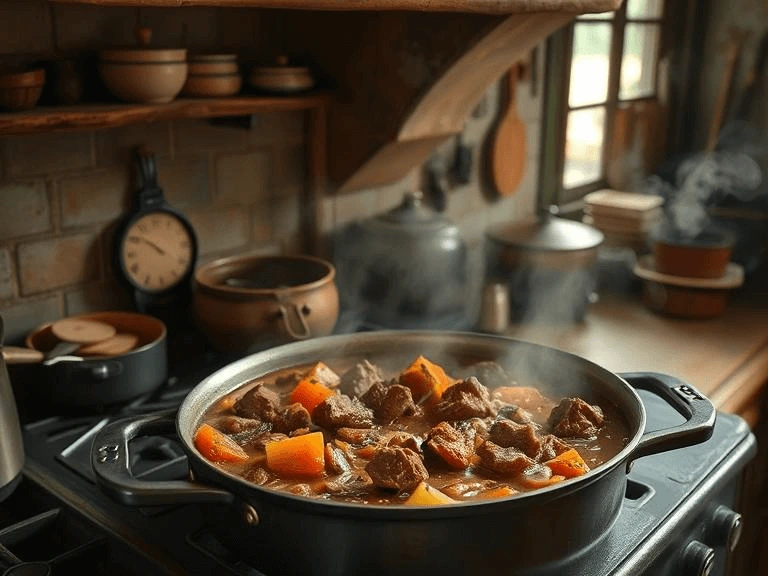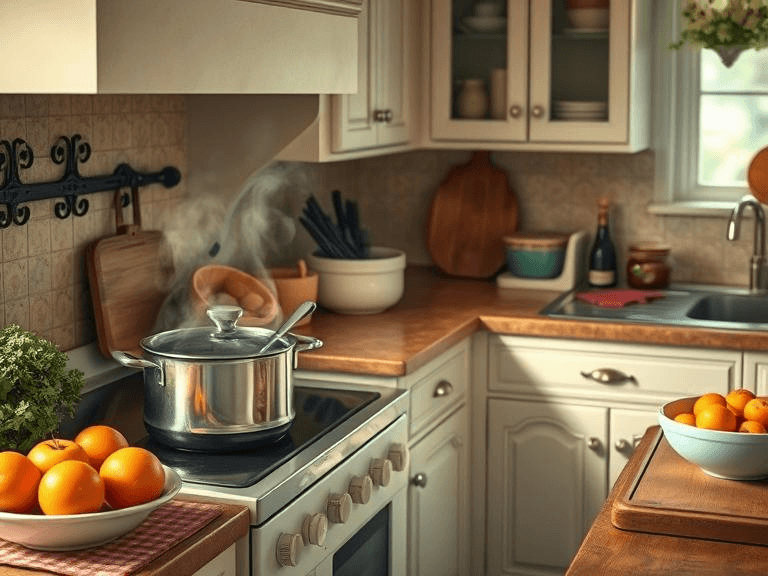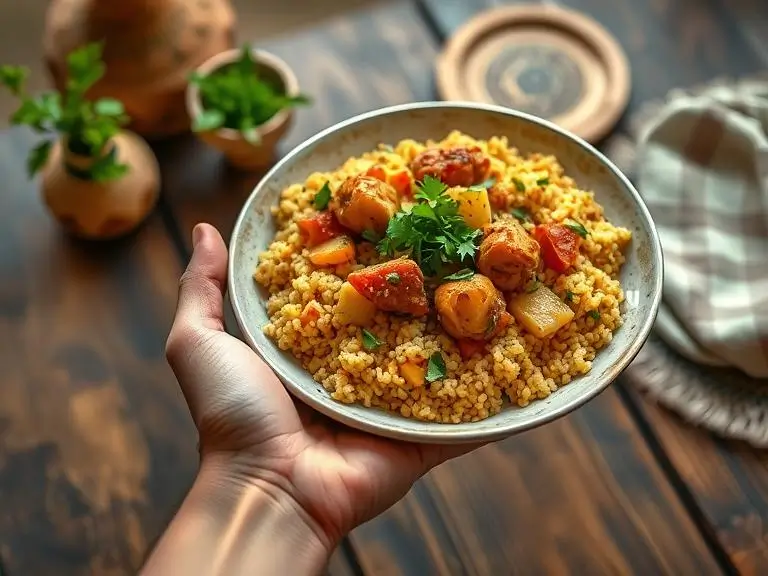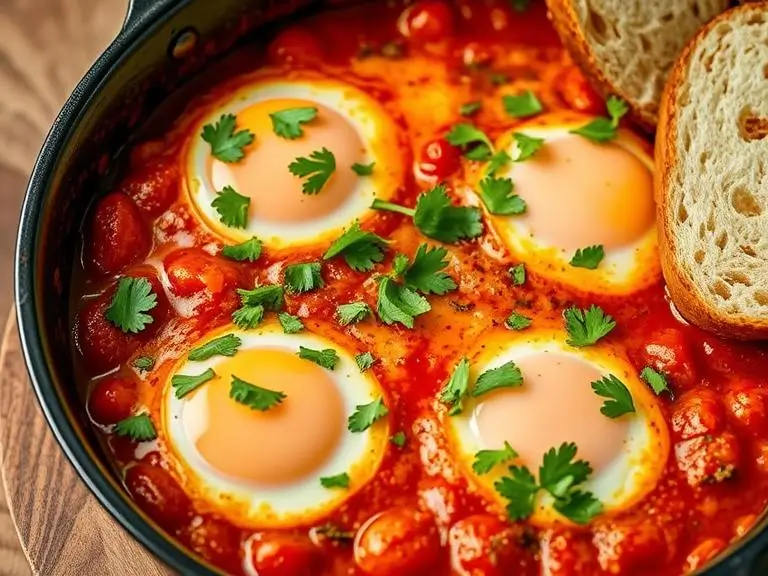Beef Stew 3 Quick Tips for Perfect Dinner
Table of Contents
Beef Stew can be the ultimate comfort food that transforms an ordinary dinner into a warm, satisfying feast. Have you ever experienced the joy of biting into a tender, flavor-packed stew that makes you forget about the day’s stress?
Imagine a chilly evening where the aroma of spices fills your kitchen, inviting you to enjoy a meal that feels like a warm hug. Beef Stew offers exactly that—a hearty dish that’s both delicious and easy to make, even for beginners.
Many home cooks face the challenge of creating a dinner that’s both nutritious and bursting with flavor. With Beef Stew, you’ll learn how to master three quick tips that will make your dinner not just good, but perfect. Drawing inspiration from a low-cooked recipe paired with garlic naan-style bread, you’ll discover techniques that bring out the best in every ingredient.
In this article, you’ll explore how to turn a basic Beef Stew into a culinary masterpiece with minimal effort. Whether you’re cooking for your family or hosting friends, these tips will help you create a meal that’s memorable, mouthwatering, and satisfying from the first bite to the last.
Understanding the Basics of Beef Stew
Cooking a perfect Beef Stew starts with understanding its core elements. In this section, you’ll discover the importance of high-quality ingredients, the right techniques, and the science behind making a rich, flavorful stew that satisfies every time.
Choosing the Right Ingredients
For a Beef Stew that stands out, selecting the best ingredients is crucial. Here are some key considerations:
- Beef Selection:
- Quality Cuts: Choose beef that is well-marbled and cut into large cubes for tenderness. Cuts like chuck or brisket work best.
- Seasoning: Don’t forget to season your beef with salt and pepper before searing. This not only enhances flavor but also helps to form a delicious crust.
- Spices and Aromatics:
- Coriander and Cumin Seeds: Toasting these spices releases essential oils that add a deep, aromatic flavor.
- Bay Leaf: A single bay leaf can subtly enhance the stew’s overall taste.
- Garlic and Ginger: These aromatics provide a robust flavor foundation. Fresh garlic and ginger are best for a vibrant taste.
- Thai Chilies: Finely chopped, they add a slight kick without overpowering the dish.
- Vegetables and Tomatoes:
- Onions: Finely chopped onions create a sweet and savory base.
- Tomatoes: Use a mix of 4 to 7 tomatoes; they break down into a rich, flavorful sauce that forms the heart of your stew.
Preparation and Cooking Techniques
A great Beef Stew isn’t just about ingredients—it’s about how you bring them together. Here’s how you can achieve that:
- Searing the Beef:
Searing locks in juices and creates a flavorful crust. Ensure your pot is hot enough before adding the beef cubes. - Toasting the Spices:
Briefly toast coriander seeds, cumin seeds, and a bay leaf to boost their aromatic qualities. This step is essential to unlock deeper flavors. - Building the Aromatic Base:
- Step 1: Add garlic, ginger, onions, and Thai chilies to your pot.
- Step 2: Cook until the onions are caramelized.
- Step 3: Incorporate tomatoes and let them break down into a smooth, thick sauce.
- Simmering to Perfection:
Once all the components are combined, let your stew simmer on low heat for around 2 hours. This slow cooking process tenderizes the beef and melds the flavors together.
Quick Tip: Integrating Garlic Naan-Style Bread
Alongside your Beef Stew, consider serving garlic naan-style bread to enhance the meal. The soft, buttery bread infused with garlic and fresh coriander pairs wonderfully with the hearty stew. For your naan-style bread, use:
- 300 g all-purpose flour
- 120 ml warm water
- 2 tablespoons plain yogurt
- 1 teaspoon each of salt, sugar, and yeast
- 2 tablespoons melted butter mixed with minced garlic and chopped coriander
This pairing provides a delightful contrast in textures and flavors that elevates your dinner experience.
Step-by-Step Guide to Perfect Beef Stew
Let’s break down the process into detailed steps that guide you from raw ingredients to a steaming bowl of Beef Stew perfection.
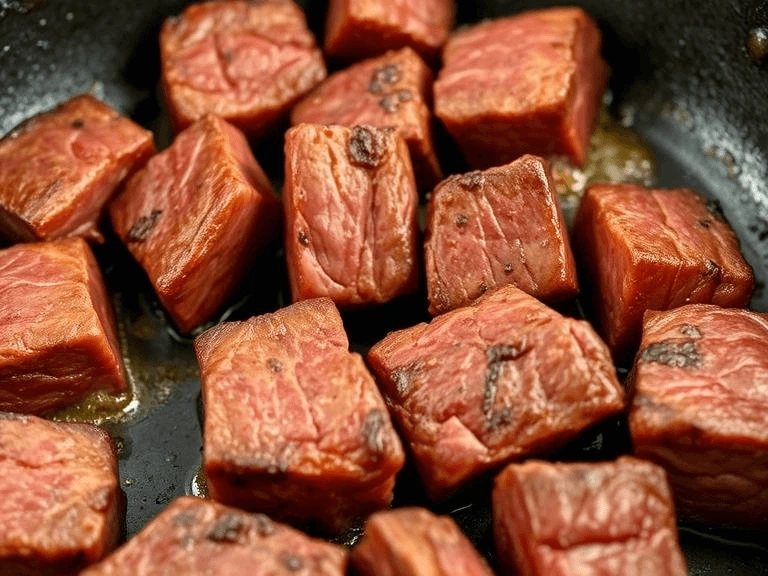
Step 1: Searing the Beef
Properly searing the beef is the foundation for a delicious Beef Stew. Follow these steps:
- Preheat Your Pot:
- Heat a large pot over medium-high heat. Ensure it’s hot before adding the meat.
- Season and Sear:
- Season: Lightly coat your beef cubes with salt and black pepper.
- Sear: Add the beef to the pot. Allow each side to brown before turning. Avoid overcrowding the pot to ensure even searing.
- Set Aside:
- Once browned on all sides, remove the beef and set aside. This step locks in the flavors, creating a savory base for your stew.
Expert Tip: Avoid steaming the meat by ensuring the pot isn’t overcrowded. Overcrowding leads to uneven cooking and a less flavorful crust.
Reliable source on searing techniques
Step 2: Toasting the Spices and Creating the Aromatic Base
Aromatic ingredients are what give your Beef Stew its distinctive taste. Here’s how to master this step:
- Toast Spices:
- Ingredients: Coriander seeds, cumin seeds, and bay leaf.
- Method: In the same pot, toast the spices for 1-2 minutes until aromatic. Stir frequently to prevent burning.
- Add Aromatics:
- Ingredients: Minced garlic, ginger, finely chopped onions, and Thai chilies.
- Method: Add the aromatics and cook until the onions become deeply caramelized, which usually takes 5-7 minutes.
- Incorporate Tomatoes:
- Steps:
- Add 4-7 chopped tomatoes to the mix.
- Stir and cook for another 5-7 minutes until the tomatoes begin to break down.
- Steps:
- Blend the Sauce (Optional):
- Method: Remove the pot from the heat and transfer the tomato mixture to a blender. Blend until smooth and return the sauce to the pot.
Expert Opinion: Blending the sauce creates a uniform texture and allows the flavors to meld together more effectively.
Learn more about flavor layering
Step 3: Simmering the Stew
Slow cooking is essential for transforming your Beef Stew into a tender, flavor-rich dish. Follow these instructions for a perfect simmer:
- Return the Beef:
- Place the seared beef cubes back into the pot with the blended sauce.
- Simmering Process:
- Bring the mixture to a simmer.
- Cover: Reduce the heat to low and cover the pot.
- Time: Let it cook for about 2 hours. Stir occasionally to prevent sticking.
- Final Adjustments:
- Taste and adjust seasoning if necessary. This is the time to add a little extra salt, pepper, or even a pinch of sugar if needed.
Real-Life Example: Many home chefs find that a slow simmer allows the beef to become incredibly tender while the flavors develop a deep, comforting profile. A friend of mine once shared that her secret was to let the stew rest off the heat for 10 minutes before serving, enhancing the taste even further.
Expert Tips for a Perfect Beef Stew Dinner
Now that you have a detailed guide to making a great Beef Stew, let’s focus on the three quick tips that can elevate your dinner from good to perfect.
Quick Tip 1: Optimize Your Searing Technique
Why It Matters:
Searing is more than just browning the meat; it locks in flavor and adds a textural contrast to your stew.
- Key Points:
- Preheat Your Pot: Ensure your pot is sufficiently hot.
- Do Not Overcrowd: Work in batches if necessary.
- Rest the Meat: Allow seared meat to rest so the juices redistribute.
Step-by-Step Searing Process:
- Preheat the pot on medium-high heat.
- Season the beef with salt and pepper.
- Sear each side until a golden-brown crust forms.
- Remove and set aside the beef to join later.
Common Mistake: Overcrowding the pan, which leads to steaming rather than searing.
Key Takeaway: Always sear in small batches for maximum flavor extraction.
Quick Tip 2: Master the Aromatic Blend
Why It Matters:
Aromatic ingredients create the flavor base of your Beef Stew. Properly cooking these ingredients results in a rich, layered taste.
- Ingredients to Use:
- Garlic, ginger, onions, and Thai chilies.
- Toasted spices like coriander seeds, cumin seeds, and bay leaf.
- Preparation Method:
- Toast spices until aromatic.
- Sauté garlic, ginger, and onions until caramelized.
- Incorporate tomatoes for a unified, rich sauce.
Expert Opinion:
Chefs often say that the depth of flavor in a Beef Stew depends on how well you build your aromatic base. Blending the sauce is optional but recommended for a smoother texture.
Common Mistake: Adding aromatics too early or burning them by cooking on too high heat.
Key Takeaway: Use medium heat and keep a close eye on the aromatics to ensure they release flavor without burning.
Quick Tip 3: Perfect the Simmering Process
Why It Matters:
Simmering transforms raw ingredients into a harmonious, tender dish. The slow cooking time allows the flavors to meld beautifully.
- Simmering Essentials:
- Low heat and a covered pot are your best friends.
- Stir occasionally to prevent any sticking.
- A 2-hour simmer is ideal for maximum flavor and tenderness.
Step-by-Step Simmering Instructions:
- Return the seared beef and blended sauce to the pot.
- Bring to a simmer and cover the pot.
- Let the stew cook on low heat for about 2 hours.
- Stir occasionally and adjust seasoning if needed.
Expert Insight:
Professional cooks often stress that patience is key. The slow simmer allows collagen in the beef to break down, resulting in a melt-in-your-mouth texture.
Key Takeaway: Let your stew simmer undisturbed for at least 2 hours for optimal tenderness and flavor.
Additional Techniques and Pro Tips
Beyond the three quick tips, there are several additional techniques you can incorporate to enhance your Beef Stew even further.
Enhancing Flavor with Additional Ingredients
Sometimes, a few extra ingredients can make your stew even more irresistible:
- Wine or Broth:
- Adding a splash of red wine or a rich beef broth can deepen the flavor profile.
- Herbs and Spices:
- Experiment with thyme, rosemary, or even a pinch of smoked paprika.
- Vegetables:
- Carrots, potatoes, or peas can add texture and nutritional value.
Creating a Balanced Meal with Garlic Naan-Style Bread
Pairing your Beef Stew with garlic naan-style bread creates a satisfying, complete dinner. Here’s how you can perfect your naan:
- Dough Preparation:
- Mix all-purpose flour with warm water, yogurt, oil, salt, sugar, and yeast.
- Knead until smooth and let the dough rise for 1 hour.
- Cooking Process:
- Roll the dough into small balls and shape into ovals or rounds.
- Cook on a hot skillet until golden brown.
- Finishing Touch:
- Brush with a mixture of melted butter, minced garlic, and chopped coriander while still warm.
Utilizing a Table for Common Mistakes
The following table outlines common mistakes in making Beef Stew and offers quick solutions:
| Common Mistake | What Happens | How to Avoid It |
|---|---|---|
| Overcrowding the pan | Steaming instead of searing | Sear in small batches |
| Burning aromatics | Bitter taste | Use medium heat and stir frequently |
| Under-seasoning | Bland, unexciting flavor | Season beef and adjust seasoning during simmering |
| Inadequate simmering time | Tough, chewy beef | Let the stew simmer slowly for at least 2 hours |
| Overcooking vegetables | Mushy texture | Add delicate vegetables later in the cooking process |
Expert Tip: Review each step before starting and ensure you have all ingredients measured out. Proper planning can significantly reduce mistakes.
Key Takeaway: Paying attention to detail in each stage of the cooking process results in a consistently delicious Beef Stew.
Incorporating Expert Opinions and Research
Research from culinary experts has shown that the Maillard reaction, which occurs during searing, is essential for developing deep flavors in meat dishes like Beef Stew. Studies have also emphasized the importance of slow cooking to tenderize tough cuts of meat while preserving nutrients.
- Expert Quote:
“The secret to a perfect Beef Stew lies in mastering both the searing and the slow simmer. It’s all about building layers of flavor,” notes a renowned chef from a leading culinary institute. - Research Data:
According to a study published on food science websites, slow cooking at low temperatures for at least 2 hours can increase tenderness by breaking down collagen, resulting in a richer texture and improved flavor profile.
Troubleshooting and Common Pitfalls
Even the most experienced cooks can encounter challenges when preparing Beef Stew. Here are some common issues and how you can troubleshoot them:
Issue 1: Tough or Chewy Beef
- Cause:
- Insufficient searing or not enough simmering time.
- Solution:
- Ensure the beef is properly seared and give the stew enough time to simmer.
- If the meat remains tough, consider increasing the simmer time by 15-30 minutes.
- Tip:
- Use a slow cooker if your stove’s heat control is inconsistent.
Issue 2: Lack of Flavor
- Cause:
- Under-seasoning or not toasting the spices long enough.
- Solution:
- Double-check seasoning at the start and adjust during simmering.
- Toast spices until aromatic to unlock their full potential.
- Tip:
- A quick taste test halfway through simmering can help you decide if more seasoning is needed.
Issue 3: Watery Consistency
- Cause:
- Excess liquid from tomatoes or added broth without proper reduction.
- Solution:
- Allow the stew to cook uncovered for the last 20-30 minutes to reduce excess liquid.
- Tip:
- If the stew becomes too thick, add a splash of beef broth to maintain balance.
Conclusion: Final Insights on Beef Stew
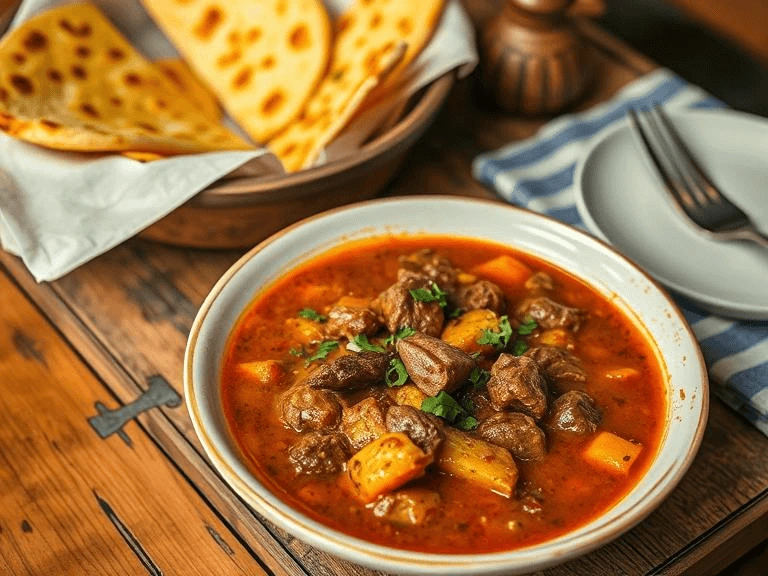
In summary, crafting the perfect Beef Stew is all about mastering the basics—from searing your beef properly, building a rich aromatic base, to letting the stew simmer slowly for that tender, melt-in-your-mouth finish. Each step is essential for creating a comforting, flavorful meal that stands out on your dinner table.
Final Thoughts:
Expert advice stresses that attention to detail and patience are the keys to success. By planning ahead, seasoning correctly, and giving your stew enough time to develop its full flavors, you’ll elevate your cooking to a whole new level. Practical recommendations include using a table checklist to avoid common mistakes and experimenting with side dishes like garlic naan-style bread to complement your Beef Stew.
Now that you have the insider tips and expert techniques at your fingertips, it’s time to head to your kitchen and try out this recipe. Share your cooking experiences and let us know how your Beef Stew turns out—your feedback and engagement help inspire others to create delicious meals too!
Also Read:
FAQ Section: Beef Stew Insights
Q1: How long does it take to prepare and cook a Beef Stew?
A: Preparation takes about 20-30 minutes, and cooking requires a slow simmer of roughly 2 hours to achieve tender, flavorful beef.
Q2: What cuts of beef are best for making Beef Stew?
A: Cuts like chuck or brisket are ideal because they are well-marbled and become tender with slow cooking.
Q3: Can I blend the sauce for my Beef Stew?
A: Yes, blending the tomato and onion mixture creates a smooth, uniform sauce that enhances the overall texture of your stew.
Q4: What are some common mistakes to avoid when making Beef Stew?
A: Avoid overcrowding the pan when searing, burning the aromatics by cooking on too high heat, and under-seasoning the dish. These errors can compromise the flavor and texture of your stew.
Q5: How can I add extra flavor to my Beef Stew?
A: Consider incorporating additional ingredients like a splash of red wine, a rich beef broth, or extra herbs such as thyme or rosemary to deepen the flavor profile.
Did this method work for you? Tell us your results!?
There are no reviews yet. Be the first one to write one.

